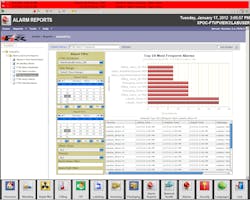Top Five Missed Opportunities with HMI Alarms and Events
With any new tech device, whether a cell phone or plant-floor controller, there is inevitably a helpful feature or two you overlooked while reading the manual or taking the introductory tutorial. Although these technological devices still perform their desired, basic functions – discovering an underutilized feature makes you wonder how you ever operated the device without it.
Interacting with alarms is one of the basic functions your operators expect from their human-machine interface (HMI) software. However, if you’re only using the standard alarming functions, you may be missing out on lesser-known features that could help you save time, ease troubleshooting and reduce headaches. The five FactoryTalk® Alarms and Events functions listed below are often overlooked and underutilized. See where they fit and if you can find some hidden tools in your plant-floor applications.
Associated Tags
In an HMI system, it is useful to have additional system information associated with an alarm for streamlined reporting and more effective handling of alarms. An alarm can be associated with up to four tags that are not only recorded in the alarm history log but can also be embedded in the alarm messages visible in an alarm summary or banner. By associating tags to include process data with event information and alarm messages, operators can automatically receive relevant information that describes what the system’s environment looked like when the alarm was triggered. For example, if you have a pump alarm associated with a flow meter output value, a tank weight, and two process valves, you’d typically have to review trending data and activity reports to understand what might have contributed to this alarm becoming active. With associated tags, you get all pertinent information in one transaction. This saves time and effort as it eliminates the need to run multiple reports and correlate the data in separate databases.
Alarm Commands
Addressing the cause of an alarm in a time-efficient manner is a top priority for operators. However, an HMI system that correctly identifies alarm conditions, does no good if the operator still has to click through multiple screens and open new programs in order to access the controls needed to correct the problem. With recent advancements, new HMI software applications can be configured to execute a command when the user double-clicks on the alarm in the alarm summary. For example, an operator can double-click an active alarm and have the appropriate screen displayed for them to take corrective action. This is especially effective in a large HMI system where the operator must have access to a process screen or device faceplate to understand the area of concern before taking action.
Preconfigured Control-Status Alarms
HMI software should be tightly integrated with plant-floor controls and enable you to capture additional data beyond alarm and event information. Collecting data related to environmental factors, such as problems with controllers and other equipment, can help operators better understand what is going on in the system. Newer HMI applications incorporate preconfigured control-status alarms that indicate when there is an issue with a controller or its connection. In addition, operators should be able to run reports showing in-depth detail regarding the conditions of the alarm. For example, with preconfigured control-status alarms, when an operator sees that data is not updating into its system, he/she can review the alarm summary and immediately see that the controller is in program mode and not run mode. This ultimately saves the operator time because he/she is no longer trying to figure out if something in this system needs correction.
Alarm Classes
When viewing many different alarms, it can be a time-consuming task to group like alarms together. Effectively organizing alarms in an alarm summary or report can actually be quite simple when using alarm classes in some applications. The alarm class is a text string of up to 40 characters that operators enter when configuring an alarm. At run time, the value of the alarm class is recorded in the alarm history log, and the content is filtered based on the value of the alarm class. This enables you to easily sort or filter your alarms by function whether for valves that fail to open or close, pressure temperature, equipment running or tank levels.
Remote Alarm Annunciation and Escalation
The last often underutilized alarm-and-event function provides operators with remote access and control capabilities. Specter Instruments, a member in the Rockwell Automation PartnerNetwork™ program, incorporates a FactoryTalk Alarms and Events subscriber plug in for its Win 911 product. With the remote alarm annunciation and escalation , FactoryTalk system notifies operators of alarms via text to speech (calling an operator’s cell phone), text pages, email or through voice-over TAPI modem. In the instance that the operator cannot be reached, the Win 911 product can utilize the escalation function based on the response rate. For example, if there is no response when an operator is contacted, the system will escalate to the line supervisor. If the line supervisor does not respond, the system will escalate to the plant manager, and so on until someone is reached who can address the alarm. Because the system is contacting people at home, it also gives employees the ability to remotely acknowledge and address the alarms.
Poorly managed alarms and events can be disasters waiting to happen. Utilize these hidden tools and start streamlining your alarm management today.
Uncover more hidden alarm and event capabilities at:
- FactoryTalk Alarms and Events overview http://www.rockwellautomation.com/rockwellsoftware/factorytalk/alarmsevents.html
- Key features presentation of FactoryTalk Alarms and Events http://www.slideshare.net/RockwellAutomation/factorytalk-alarms-and-events-overview
- FactoryTalk Alarms and Events photos http://www.flickr.com/photos/rockwellautomation/sets/72157629100823803/
- Rockwell Automation Manufacturing Intelligence http://discover.rockwellautomation.com/IS_EN_Performance_HMI_Software.aspx
- Specter Instruments alarm annunciation and escalation http://www.specterinstruments.com/
To learn more, join us at RSTechED. Session selection guide available here.
FactoryTalk and PartnerNetwork are trademarks of Rockwell Automation, Inc.

